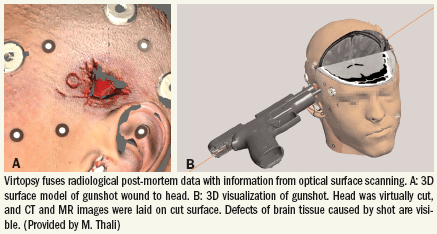Advanced methods assist in scene-of-crime investigations and post-mortems
Forensic radiography sessions have become a fixture at medical imaging conferences. Delegates are guaranteed a good visual show, with presenters displaying many novel images seldom seen in clinical radiology departments.
Forensic radiography sessions have become a fixture at medical imaging conferences. Delegates are guaranteed a good visual show, with presenters displaying many novel images seldom seen in clinical radiology departments.
At ECR 2009, however, speakers at the forensic session stressed the importance of organization, training, and professional recognition. The emphasis was on high-quality service, not quirkiness.
The provision of forensic imaging services has traditionally been a bit haphazard, said Mr. Jonathan McNulty, a lecturer in diagnostic imaging at the University of Dublin. Now training and postgraduate education courses are being established, and local groups are banding together to form national and international organizations.
“People are coming to realize the need for dedicated teams and proper protocols,” he said.

The value of an organized, professionally led forensic imaging service was illustrated by Catherine Rock, chair of the International Association of Forensic Radiographers. The U.K. now has its own forensic radiography response team, composed of radiographers with accredited training and experience in forensic and mass fatality imaging. A store of diagnostic imaging equipment that can be deployed in the event of a major incident has also been funded by the U.K. government.
The response team received its first call-out on July 7, 2005, when bombs were detonated simultaneously on three London underground trains and a double-decker bus. A total of 24 radiographers assisted with the forensic investigation, imaging 56 bodies and 1162 body parts over a 17-day period.
The aims of the imaging work were twofold: to identify victims of the bombings and to identify foreign objects inside the body bags that could potentially injure the pathologists or that might be relevant to the police investigation.
Whole bodies were scanned head-to-toe with fluoroscopy on arrival at the emergency mortuary, Rock said. These initial surveys were undertaken by teams of two radiographers and a pathologist. The scans showed the location of personal effects and sharp objects, as well as prostheses or implants that could be used for identification purposes. Injuries sustained by victims were documented. Once the body bag had been opened, intra-oral x-rays were taken to compare with dental records. Body parts were examined using digital and computed radiography.
“Radiographers are used to dealing with trauma, but some people would find that this wasn’t for them,” she said. “We wouldn’t involve anyone who had not been through some kind of training. You are also working within a very different kind of team-not just medical professionals such as pathologists, but the police, too.”
Advanced imaging techniques can aid scene-of-crime investigations and post-mortem examinations, according to Prof. Michael Thali, director of the Institute of Forensic Medicine at the University of Bern. The “Virtopsy” system pioneered at Bern is an entirely imaging-led approach to forensic investigation. Advocates for the system believe that it may eventually replace invasive methods of forensic pathology.
A key part of the Virtopsy approach is the 3D representation of all objects involved in the incident under investigation. For example, if a patient has been killed while riding a bicycle, investigators will make a virtual 3D model of that bicycle, as well as the patient’s body. An optical measuring process known as photogrammetry is used to attain 3D coordinates of discrete points on the objects being modeled. Surface data are then acquired using 3D optical scanning.
Cross-sectional imaging plays an important role. Anatomical information that would typically be collected during an invasive post-mortem examination is acquired from whole-body MR and/or CT scans. MR spectroscopy techniques are also being tested as a way to determine time of death.
“What is special about our method is that we are documenting everything using imaging methods and merging everything in a single data set,” Thali said.
Interest in the Swiss group’s approach to forensic medicine is growing. A basic Virtopsy course, held twice a year, attracts attendees from institutions worldwide. The first advanced Virtopsy course will be held later in 2009.
“We have seen a real change in people’s views,” he said. “When we started showing these techniques 10 years ago, many people said, ‘That’s science fiction.’ Now the same individuals are starting to use some of these advanced forensic imaging techniques for themselves.”
GE HealthCare Debuts AI-Powered Cardiac CT Device at ACC Conference
April 1st 2025Featuring enhanced low-dose image quality with motion-free images, the Revolution Vibe CT system reportedly facilitates improved diagnostic clarity for patients with conditions ranging from in-stent restenosis to atrial fibrillation.
The Reading Room Podcast: Current Perspectives on the Updated Appropriate Use Criteria for Brain PET
March 18th 2025In a new podcast, Satoshi Minoshima, M.D., Ph.D., and James Williams, Ph.D., share their insights on the recently updated appropriate use criteria for amyloid PET and tau PET in patients with mild cognitive impairment.